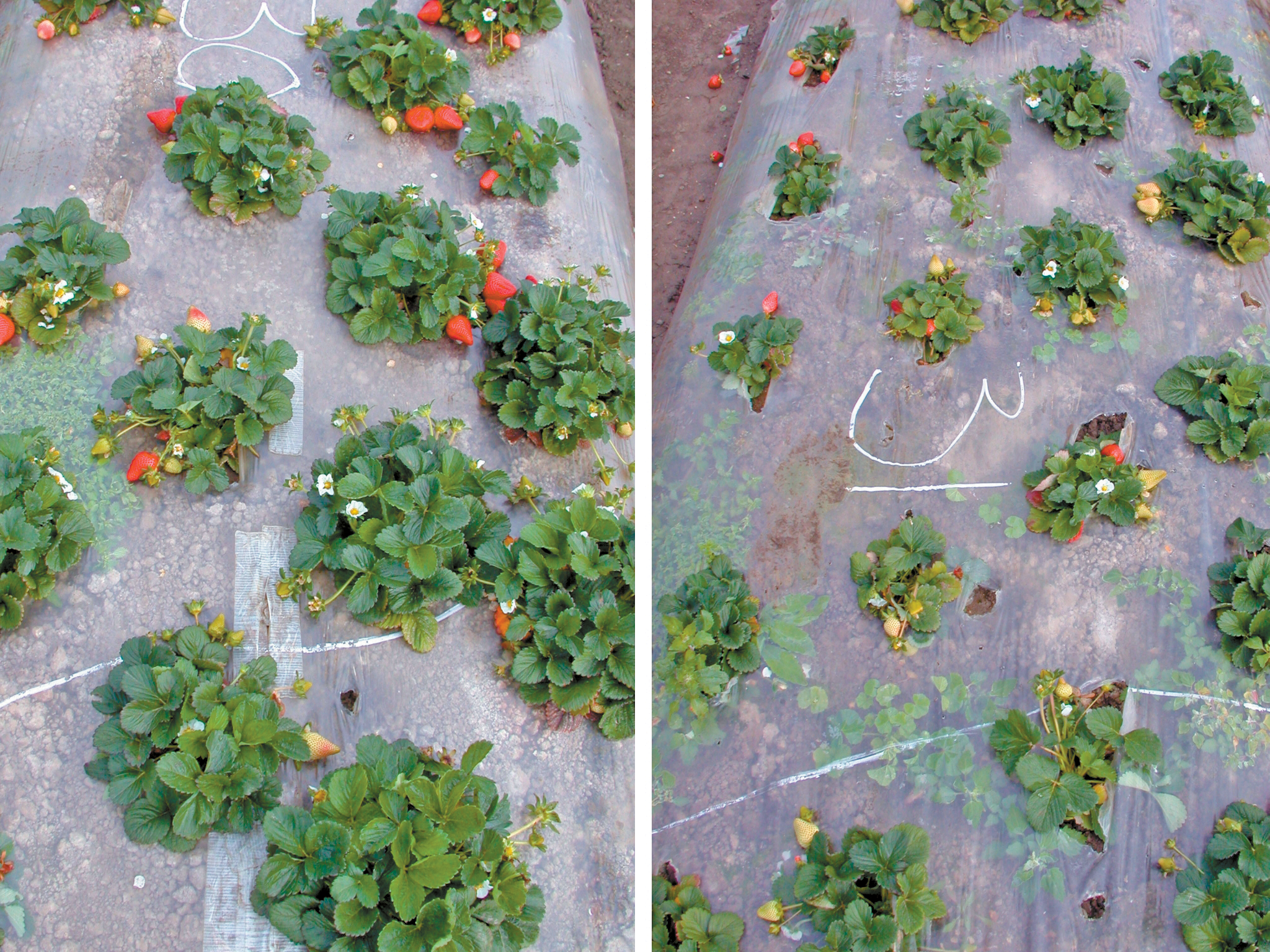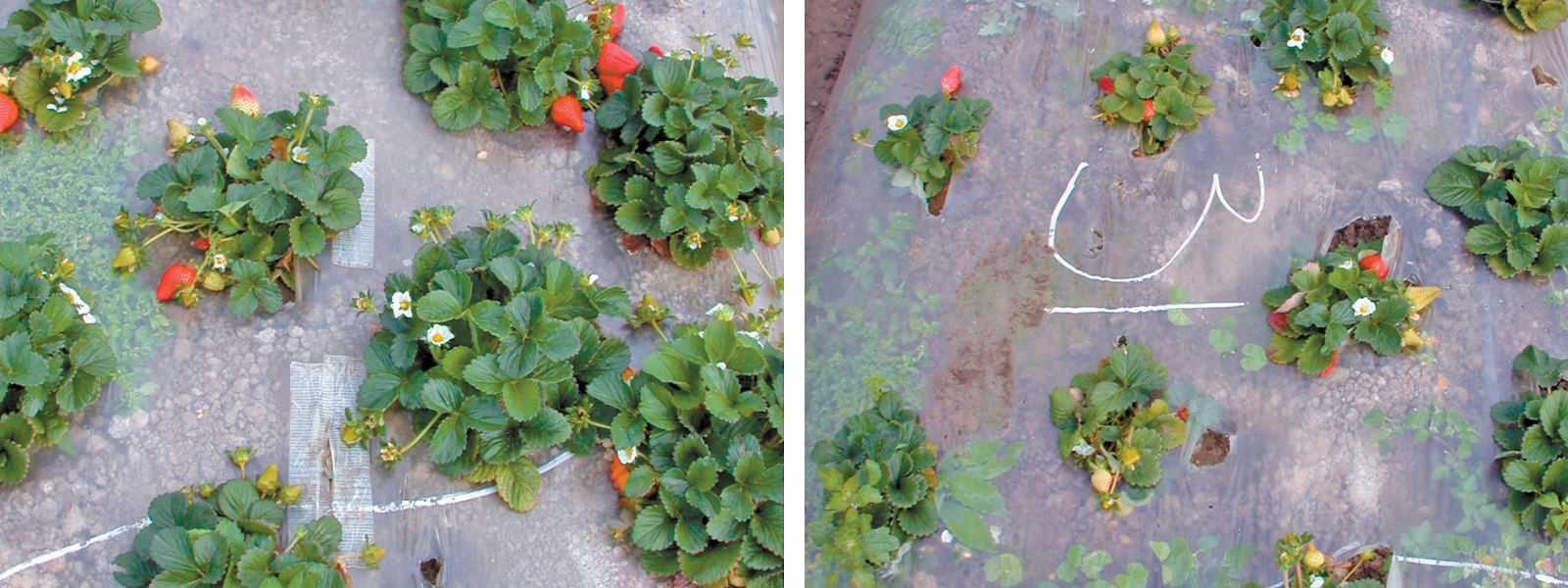Organic strawberries benefit from soil treatment

Some organic strawberry fields that undergo a preplant anaerobic soil disinfestation, or ASD, treatment to combat soil-borne pathogens demonstrate stronger plants and better yields, left, compared to untreated fields, right, according to University of California research.
Photo/Oleg Daugovish

By Christine Souza
Organic strawberry growers in California have increased adoption of a technique that suppresses soil-borne pathogens and, in some cases, weeds, leading to more robust plants and improved yields.
The preplant soil treatment known as anaerobic soil disinfestation, or ASD, emerged as a nonchemical alternative to methyl bromide, a phased-out fumigant used in conventional strawberries that proved effective in controlling pathogens, weeds and nematodes.
Joji Muramoto, assistant cooperative extension organic production specialist at the University of California, Santa Cruz, said he has experimented with ASD since the early 2000s, when it was introduced in the U.S. from the Netherlands and Japan.
UC researchers received help from counterparts overseas in response to a 2001 outbreak of Verticillium wilt caused by the pathogen Verticillium dahliae at the university’s organic strawberry farm. Muramoto and Carol Shennan, a professor in the Department of Environmental Studies at UC Santa Cruz, were among the first to try the technique in California.
“It took us a while to figure out how to do it, but it worked in the organic field, so we thought, let’s try it,” Muramoto said. “We learned from the Dutch method and the Japanese method and tried to optimize it for California.”
Growers apply the technique in the fall before planting. They broadcast into the soil a carbon source, such as rice bran, wheat bran or dried distillers’ grain, which is easily digestible by microbes. The soil is covered with plastic to limit oxygen, and the field is drip irrigated. This initiates a three-week biological process of anaerobic decomposition of the carbon source, Muramoto said.
“Even a handful of soil contains more microorganisms than the entire human population,” he said. “There are so many tiny microbes in there, and they are usually carbon limited, so once you apply something like rice bran or wheat bran, they have a big party.
“The purpose of this treatment is to create a fermentation process, which happens under the oxygen-limited conditions,” he added.
Santa Cruz organic farmer Rich Everett of Everett Family Farm in Soquel said of the approach: “It really worked for us. It became standing operating procedure for our strawberries.
“It was recommended that we try (ASD), so we did. This kills the bad nematodes in the soil, but it also sterilizes all kinds of stuff, which gives us a really healthy strawberry plant,” Everett added. “Our customers consider our strawberries the best around, so we think the technique not only acts as a disinfectant for the soil but it enhances fruit quality.”
After several years of replicated field trials, Muramoto said he and fellow UC researchers have seen encouraging results.
In an average of 10 replicated trials, the relative yield of the ASD-treated organic strawberry fields was 99% of fumigated control, so almost identical to conventional fruit yield. In addition, researchers saw control of soil pathogens and increased fruit yields in ASD-applied fields. Yields in organic strawberries increased by 60% to 70%, he added.
In Southern California, Oleg Daugovish, UCCE strawberry and vegetable crop advisor in Ventura County, is working with organic farmer Glen Hasegawa of Faria Farms in Oxnard, who has used the ASD technique by applying rice bran for three years.
“The farmer saw annual improvements such as a decrease in incidence of charcoal rot-related decline and yellow nutsedge germination and fruit yield improvements,” Daugovish said.
In trials this year, he said research showed wheat middlings, which cost 20% less than rice bran, performed as well as or better than rice bran at suppressing charcoal rot and nutsedge, with good results in crop quality.
While researchers found ASD beneficial to organic productivity and soil health, Daugovish and Muramoto noted some limitations in suppressing the top strawberry diseases—Verticillium wilt, Fusarium wilt and charcoal rot. In coastal areas with cooler soil temperatures, ASD can actually exacerbate the latter two diseases, as the fungal pathogens feed on the rice bran.
“To control these pathogens with this approach, you need higher soil temperature, which is hard to do in coastal California during the fall treatment,” Muramoto said. “The technique is not a silver bullet, but it definitely works for some organic growers. It has added a tool to their toolbox.”
Adoption of ASD by California strawberry growers has grown significantly during the past two decades. Tracking the purchase of rice bran, Muramoto estimated about 2,500 acres, or about half the state’s 5,200 organic strawberry acres, were treated last year with ASD-related practices. The treated acres include large-scale growers who skip the fermentation step that kills soil-borne pathogens but use rice bran as a fertilizer, he said.
“This is OK as long as they don’t have soil-borne disease issues,” Muramoto said.
“I wouldn’t think of not using the process,” Everett said. “For us, it’s instilled in the farm, and until someone comes up with something better, this works. There is some cost, but there’s no downside.”
For Ventura County farmer Phil McGrath in Camarillo, the technique needs more refinement.
“I’ve used it (ASD) before, but it was expensive in my world,” he said. “We really never figured out an application process that worked mechanically, so we had to do it by hand.”
McGrath said he uses compost and cover crops to boost soil health. “If you’ve got a lot of weeds and they seeded, then this is great to kill weed seed and get nematodes,” he said. “But you don’t want to kill the worms and bugs that are hidden in the soil.”
Researchers said future trials include studying lower-cost carbon sources to compare effectiveness and ease of application for growers interested in using ASD. Due to the high cost of the carbon source, Muramoto said the technique is mostly used in high-value crops. With an application rate of 6 tons per acre, the cost to apply rice bran, which costs $300 a ton or more, ranges from $1,800 to $2,000 an acre, he said.
As for broadening use of ASD, Everett said he hasn’t yet tried the treatment in other crops such as organic vegetables but believes it could be effective. He said his strawberries are flavorful due to many reasons.
“We pick them fresh when they’re ripe,” he said, adding that “part of that equation is having healthy soil.”
(Christine Souza is an assistant editor of Ag Alert. She may be contacted at csouza@cfbf.com.)




